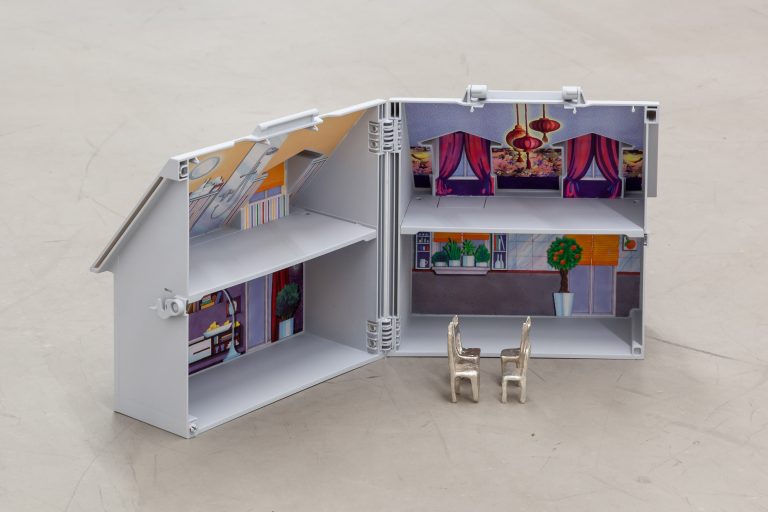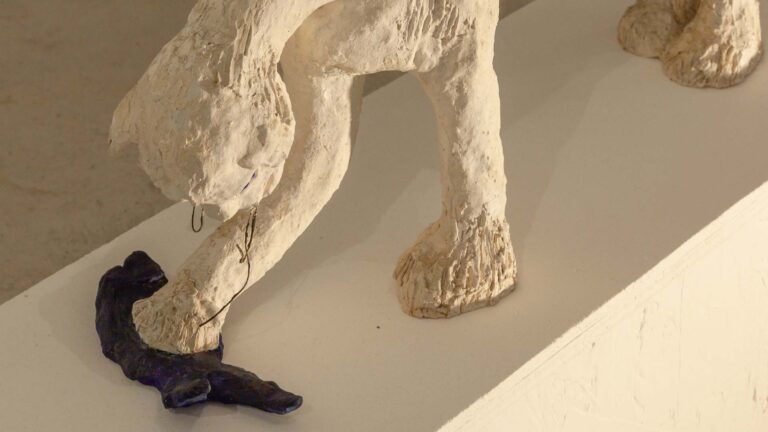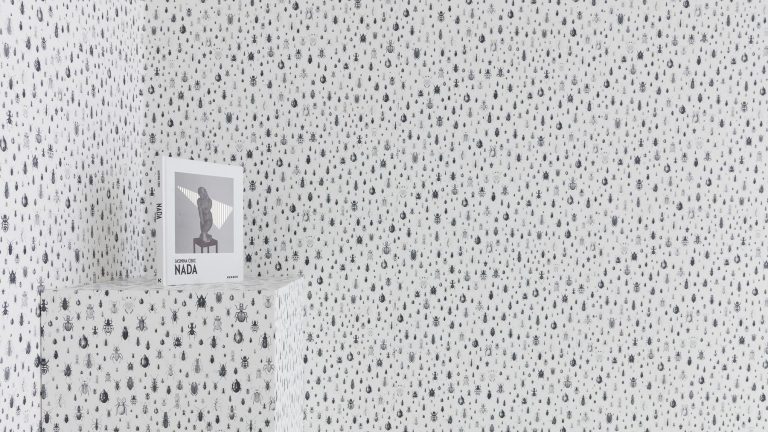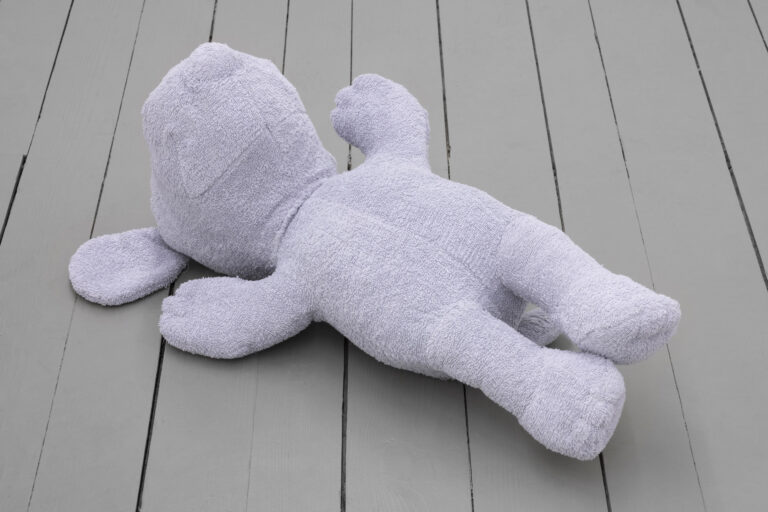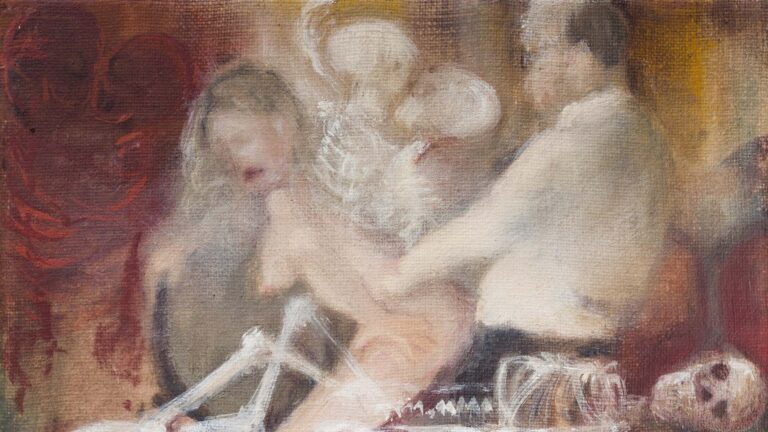Artist: Guy Mees
Exhibition title: The weather is quiet, cool and soft
Curated by: Lilou Vidal
Venue: Kunsthalle Wien, Vienna, Austria
Date: February 1 – April 29, 2018
Photography: all images copyright and courtesy of the artist and Kunsthalle Wien
Note: Exhibition booklet can be found here
Guy Mees (1935–2003) was a leading figure of the Belgian avant-garde. Although his work has been acknowledged in Belgium since the 1960s, he is still rather unknown abroad. One reason for this may be due to the fact that his œuvre does not relate to common aesthetic and discursive definitions and remains rather enigmatic.
The weather is quiet, cool and soft shows works from different phases in the career of the Belgian artist Guy Mees (1935–2003) to shed light on his intuitive and conceptual approach. The selected works range from early lace pieces generically titled Lost Space, to the films and the photographs of the Portraits series (Level differences), never before shown structuralist works from the 1970s, pastel on paper series from the mid-seventies, the Lost Space paper cut-outs from the 1980s, and his last works with watercolours on tracing paper from the 2000s.
Together, they allow a study of Mees’ practice and his ideas of mutability, fragility, porosity and the shattering of pictorial space in ordinary space.The title of the exhibition (borrowed from a note by the artist on a work on paper) characterizes the atmospheric impermanence in Mees’ work, and his relativist poetic approach.
As a member of the “New Flemish School” he was in touch with an international network of artists affiliated with the neo-avant-garde from Europe, Japan, and North and South America (Spazialismo, Zero, Nul, G.R.A.V, Azimut/h, and Gutai, to name but a few), who shared an interest in light, serial structures, movement, and monochrome.Guy Mees quickly gained recognition among the transnational avant-garde from the early 1960s onwards. However, his non-authoritarian attitude and conceptual approach to deconstruct any form of classification soon led him to take an alternative path where the liberation of systems, structures and media, in order to create freedom and openness, became both idiosyncratic and tangible.
The films and photo series Portraits (Level differences) with groups of three people spontaneously placed on different levels of three moveable concrete blocks are reminiscent of amateur works. Apart from the six possible positions (1.2.3, 1.3.2, 2.1.3, 2.3.1, 3.1.2, 3.2.1), the series can vary ad infinitum, thus demonstrating the changing nature of a phenomenon and the arbitrary nature of the norm. The subsequent works on paper 1,2,3 use photos from contact sheets and place them according to a grid, like a sensitive mathematician’s notes. Apart from the absurdity of the mechanistic endeavours, these films and photos depicting friends and family provide a fascinating portrait of the Belgian avant-garde gravitating around the MTL (Fernand Spillemaeckers) and X-One (Marc Poirier dit Caulier) galleries, in addition to international views such as the 1974 series portraying Nicholas Serota at The Museum of Modern Art in Oxford.
The principle of six positions brought Mees to a new formal exploration of combinations according to a chromatic chart that features lines in six different colours drawn by hand on thin paper (i.e. newsprint), which he then organised in columns and grouped in multiples of three. While the overall composition, its automatic nature and repetition of pattern and gesture belong to a mechanical process close to the printing press, the sheets’ character distances from these initial references as we move toward a random reading. Slowly the lines begin to reveal a sparse universe of marks of colour on thin paper whose design at times almost mirrors the wall and pierces its interior, thus opening the way for the paper cut-outs, Lost Space, and later for the Imaginary Ballet.
The Lost Space works also summon the idea of a deconstructed frame. Support, form, and color become fused in the concrete space and reveal the interstitial zone through which art can connect to reality, with the former as an emanation of the latter. The white panels and structures of the early 1960s, made from industrial lace, mix minimalist forms with sensual if not erotic textures, exposing a diffuse interior space. The more volatile shapes of cut-outs pinned to the wall from the 1980s whose color fragments sculpt the density and voids of architecture activate the space as an image and reveal the inbetweenness of gaps and remainders. Whether pieces from either period the Lost Space recall the starting point and culmination of conceptual and poetic reasoning in the work of Guy Mees. They are “filled with that of which it is its outcome, filled with its loss.” (Dirk Pültau).
Apart from being Guy Mees’ first exhibition in Austria, and one of the few international ones so far, it will also be the first time that archival materials from his estate will be presented. This will provide further insight into the mind of an artist who, during his entire lifetime, rejected any analytical discussion about his work in favor of its perceptive experience.
Installation view: Guy Mees. The weather is quiet, cool and soft, Kunsthalle Wien 2018, Photo: Jorit Aust
Installation view: Guy Mees. The weather is quiet, cool and soft, Kunsthalle Wien 2018, Photo: Jorit Aust
Installation view: Guy Mees. The weather is quiet, cool and soft, Kunsthalle Wien 2018, Photo: Jorit Aust: Verloren Ruimte (Lost Space), 1960–1967, Courtesy Estate of Guy Mees, Lotte Boogh Mees, Galerie Micheline Szwajcer, Antwerp
Installation view: Guy Mees. The weather is quiet, cool and soft, Kunsthalle Wien 2018, Photo: Jorit Aust: Untitled, 1972–1975; Herfst (Fall), 1974; Voorjaarsmorgen (Spring Morning), 1976–1978, Courtesy Estate of Guy Mees, Lotte Boogh Mees, Galerie Micheline Szwajcer, Antwerp
Installation view: Guy Mees. The weather is quiet, cool and soft, Kunsthalle Wien 2018, Photo: Jorit Aust: Verloren Ruimte (Lost Space), 1965, Courtesy Estate of Guy Mees, Lotte Boogh Mees, Galerie Micheline Szwajcer, Antwerp
Installation view: Guy Mees. The weather is quiet, cool and soft, Kunsthalle Wien 2018, Photo: Jorit Aust
Installation view: Guy Mees. The weather is quiet, cool and soft, Kunsthalle Wien 2018, Photo: Jorit Aust
Installation view: Guy Mees. The weather is quiet, cool and soft, Kunsthalle Wien 2018, Photo: Jorit Aust: 4 X (100 x 1250 x 10) mm, 1970, Courtesy Estate of Guy Mees, Lotte Boogh Mees, Galerie Micheline Szwajcer, Antwerp
Installation view: Guy Mees. The weather is quiet, cool and soft, Kunsthalle Wien 2018, Photo: Jorit Aust
Installation view: Guy Mees. The weather is quiet, cool and soft, Kunsthalle Wien 2018, Photo: Jorit Aust: Verloren Ruimte (Lost Space), 1986–1989, Courtesy Private collection, Estate of Guy Mees, Galerie Micheline Szwajcer, Antwerp & Lotte Boogh Mees
Installation view: Guy Mees. The weather is quiet, cool and soft, Kunsthalle Wien 2018, Photo: Jorit Aust: Untitled, 2003, Courtesy Estate of Guy Mees, Galerie Micheline Szwajcer, Antwerp & Lotte Boogh Mees
Installation view: Guy Mees. The weather is quiet, cool and soft, Kunsthalle Wien 2018, Photo: Jorit Aust: Verloren Ruimte (Lost Space), 1960–1964, Courtesy Estate of Guy Mees, Galerie Micheline Szwajcer, Antwerp & Lotte Boogh Mees
Installation view: Guy Mees. The weather is quiet, cool and soft, Kunsthalle Wien 2018, Photo: Jorit Aust: 1,2,3, 1970, Courtesy Estate of Guy Mees, Galerie Micheline Szwajcer, Antwerp & Lotte Boogh Mees
Guy Mees, Portraits (Level Differences), 1970, Courtesy Estate of Guy Mees, Lotte Boogh Mees, Galerie Micheline Szwajcer, Antwerp
Guy Mees, Untitled, 1975–1978, Photo: Vildana Memic, Courtesy Estate of Guy Mees, Lotte Boogh Mees, Galerie Micheline Szwajcer, Antwerp
Guy Mees, Verloren Ruimte (Lost Space), 1986–87, Photo: Philippe De Gobert, Courtesy Estate of Guy Mees, Private collection
Guy Mees, Untitled, 1970, Photo: Isabelle Arthuis, Courtesy Estate of Guy Mees, Lotte Boogh Mees, Galerie Micheline Szwajcer, Antwerp
Portrait of Guy Mees, 1968–1969, Photo: Marc Poirier dit Caulier, Courtesy Estate of Guy Mees, Private collection, Antwerp



















